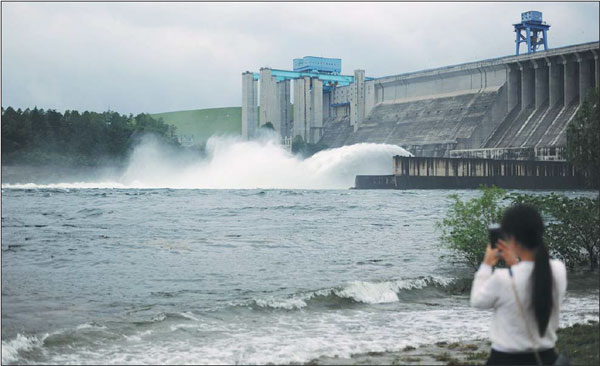Sweet flows of water transform lives in Beijing
Giant north-south program is turning arid, dry area into verdant enclave, Cao Yingying reports.
Since the first stage of the spectacular South-to-North Water Diversion Project was officially put into operation in December 2014, a virtual tidal wave of water - an estimated 3 billion cubic meters plus - has been carried into Beijing, benefiting more than 11 million residents in the capital.
Designed to transport water from southern China to the arid northern regions through separate channels, the South-to-North Water Diversion Project has added water flows to Beijing's supply for three years.
One of the most expensive engineering projects ever undertaken in the world, the scheme was first discussed by China's leaders in the 1950s - aiming to channel over 40 billion cu m of fresh water each year from the Yangtze River in southern China to the more arid and industrialized north.
In the second year of the project, Beijing received 1.1 billion cu m of water from southern regions, which exceeded the planned volume of water supply and achieved the five-year goal of the project ahead of schedule.
"The water entering Beijing not only increases total volumes of water resources and guarantees the local water supply, but also improves water conditions for local residents," said Sun Guosheng, director of the Beijing South-to-North Water Diversion Project office.
According to official statistics, Beijing, classified as a severely arid region, has had average annual precipitation of 585 millimeters and 3.74 billion cu m of average annual water resources for some years.
To solve the problem, the Beijing government set up eight plants with storage facilities to hold the water from southern China, which provide 3.7 million cu m to the city's central areas every day.
The diverted water from outside Beijing can reach 3.4 million cu m on average per day. Of that, 2.25 million cu m goes to the water plants, accounting for more than 70 percent of central area's daily supplies.
The project has served the city's central area and Daxing and Mentougou districts, as well as parts of Changping, Fengtai and Tongzhou districts.
With more water plants in the pipeline, more Beijing residents will benefit from the water diversion project.
The city government has set up a water delivery system especially for the water flows from the diversion project, routing the water around Beijing's fourth and fifth ring roads, and another water line to deliver water to the capital's eastern and western regions, as well as Miyun Reservoir.
These routes help to guarantee the safety in water deliveries, supply and use in Beijing and another ring road for water supply will be added in the future, government officials said.
In addition, the Beijing municipality has increased Miyun Reservoir's storage capacity to extend the terminal of the South-to-North Water Diversion Project to there.
The water stored at the reservoir is now over 2 billion cu m, which according to the data collected since 2000 is a record high. The facility, built in 1960 as a mountain valley reservoir, is the largest reservoir in Beijing area. Two main rivers, Chaohe and Baihe, flow into it.
The increased capacity expands the regions benefiting from southern water and increases the strategic reserve of water resources in Beijing, which has achieved a seamless convergence and switching between southern and local water, officials said.
To ensure the quality of water flowing in, the Beijing municipal government keeps a close watch on the diversion project's operations - especially at critical points in the water shipment process, including access to the city and to water plants - to deal with any water pollution emergencies.
Beijing Waterworks Group, a State-owned water supplier, has installed more than 500 online water quality monitors in the city's water supply network. This, officials said, helps to achieve real-time online monitoring of water quality from water sources to users' terminals.
The water diversion project has also moved to integrate with the city's push for ecological improvement, local officials added.
To promote exchanges in complementary resources between northern and southern China, 16 districts in Beijing have established cooperative relations with 16 counties in Henan and Hubei provinces and launched a series of exchange activities.
By the end of this year, their governments had set up 2 billion yuan ($302.87 million) in cooperative funds for 665 projects, including 118 water-related projects valued at 660 million yuan.
Beijing also released a cooperative plan at the beginning of this year, earmarking 500 million yuan to support the development of the water source areas every year.
Over the next five years, Beijing will continue to push to solve the problem of the water resources shortage, guarantee the safety of water sources and improve the environment to provide more convenience to Beijing residents, local officials said.
Contact the writer at caoyingying@chinadaily.com.cn
|
Danjiangkou Reservoir in Central China's Hubei province is the start of the South-to-North Water Diversion Project's central route, from which water is diverted to Beijing.Zhang Xinjun / For China Daily |
(China Daily 12/27/2017 page7)















